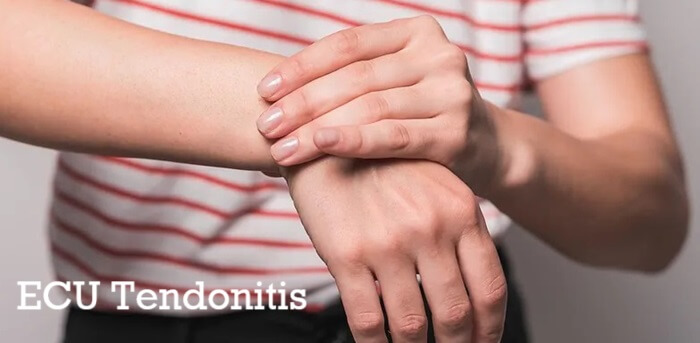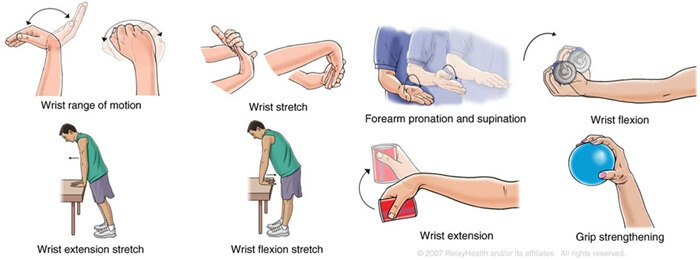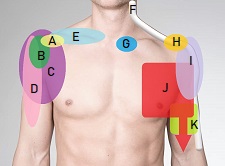- Home
- Wrist Pain Diagnosis
- Wrist Tendonitis
- ECU Tendonitis
Extensor Carpi Ulnaris Tendonitis
Written By: Chloe Wilson BSc (Hons) Physiotherapy
Reviewed By: SPE Medical Review Board
Extensor Carpi Ulnaris tendonitis causes pain and inflammation on the pinky side of the wrist.
It is a common type of wrist tendonitis caused by overuse or repetitive wrist and hand movements.
Extensor Carpi Ulnaris tendonitis can affect people of any age and affects athletes, office staff and construction workers alike.
Tenderness, weakness and clicking/grating noises are common features of tendonitis of the extensor carpi ulnaris (ECU) muscle.
Most cases of ECU tendonitis will settle down within a few weeks with a combination of rest, physical therapy, exercises and splinting, but more persistent cases may require injections or surgery.

Here we will look at the common causes and symptoms of extensor carpi ulnaris tendonitis, how it is diagnosed, the best treatment options and how to prevent it from coming back.
What Is Extensor Carpi Ulnaris Tendonitis?
Extensor carpi ulnaris tendonitis is a type of wrist tendonitis where there is the inflammation, irritation and thickening of the ECU tendon.
The ECU tendon is one of the major tendons of the wrist, located on the ulnar (pinky) side of the wrist. It connects the extensor carpi ulnaris muscle of the forearm to the base of the little finger.

The Extensor Carpi Ulnaris tendon helps to:
- Extend The Wrist: bend it backwards, lifting the hand up
- Adduct The Wrist: move the wrist sideways (ulnar deviation), bringing the pinky side of the wrist towards the side of the forearm
- Stabilize The Wrist: provide medial stability
Extensor carpi ulnaris plays a key role in activities that involve repetitive hand and wrist movements, such as playing sports or working with tools. When the tendon is overused or subjected to excessive stress, it can become irritated and inflamed, causing pain and dysfunction in the wrist and resulting in extensor carpi ulnaris tendonitis.
Causes of ECU Tendonitis
Common causes of extensor carpi ulnaris tendonitis include:
- Repetitive Wrist Movements: Extensor carpi ulnaris tendonitis is common among athletes who engage in sports requiring repetitive wrist and forearm motions, particularly in activities like tennis, golf, rowing, and rock climbing. These sports often involve a lot of ulnar deviation and wrist extension, which put strain on the ECU tendon. Jobs that require constant wrist and hand movements, such as typing, using tools, or assembly line work, can also lead to ECU tendonitis. Constant wrist extension and twisting movements increase the risk of tendon inflammation.
- Trauma or Injury: A sudden impact, fall, or excessive strain on the wrist can cause inflammation in the tendon. Acute injuries, such as a direct blow to the wrist, a fall on an outstretched hand, or a sharp twisting motion, can damage the ECU tendon, leading to pain and dysfunction.
- Improper Technique in Sports: Improper form during activities like tennis or golf can place abnormal stress on the wrist and forearm tendons, particularly if you’re repeatedly using incorrect grips or wrist positions. For example, golfers who hold their clubs too tightly or tennis players who over-extend their wrists during backhands are at higher risk of developing ECU tendonitis.
- Excessive Wrist Loading: Activities that involve heavy lifting or forceful wrist motions—such as weightlifting, repetitive manual labor, or carrying heavy loads—can put significant strain on the ECU tendon. If the wrist is not properly stabilized during these activities, it can lead to overload and tendon inflammation.
- Arthritis: People with arthritis in the wrist may develop extensor carpi ulnaris tendonitis due to the increased friction between the tendon and nearby structures. Osteoarthritis and rheumatoid arthritis can weaken the structures around the tendon, leading to tendon irritation and inflammation. Degenerative changes over time also increase the likelihood of tendon issues in older adults.
- Anatomical Variations: Some individuals have naturally looser or more unstable ECU tendons. When the tendon does not sit securely in its sheath, it can become more prone to subluxation (partial dislocation), leading to increased friction, irritation and inflammation over time.
- Underlying Wrist Instability: In some cases, extensor carpi ulnaris tendonitis develops in individuals with underlying wrist instability, such as those with ligament injuries, prior wrist fractures, or chronic wrist subluxation. When the wrist is unstable, the ECU tendon compensates to maintain balance, leading to overuse and irritation.
- Sudden Increases in Activity Level: A rapid increase in the frequency, intensity, or duration of physical activities can overwhelm the tendons. For instance, a sudden jump in tennis practice or starting a new, intense workout routine can irritate the ECU tendon if the body hasn’t been conditioned to handle the added stress.
Symptoms of ECU Tendonitis
ECU tendonitis typically presents with symptoms localized to the ulnar side of the wrist. Key symptoms of extensor carpi ulnaris tendonitis include:
- Pain on the Pinky Side of the Wrist: The most common symptom of extensor carpi ulnaris tendonitis is ulnar wrist pain along the pinky side of the wrist, especially during activities that involve wrist movement, such as gripping or twisting. This pain is typically felt just below the bony prominence of the ulnar styloid (a small bump on the wrist). ECU tendonitis often starts with mild discomfort but can worsen over time with continued activity. It may feel like a dull ache at rest and become sharper or more intense during wrist movements. The pain usually settles with rest, but in chronic cases, may become constant, even at rest.
- Swelling: Inflammation around the tendon may cause visible swelling on the outside of the wrist. In some cases, the skin around the swollen area may feel warm or appear red, especially if the inflammation is more pronounced.
- Tenderness to Touch: The area over the ECU tendon is often tender to the touch, especially when pressing directly on the tendon or surrounding tissues.
- Weakness & Reduced Grip Strength: Weakness in the wrist or hand is a common symptom of extensor carpi ulnaris tendonitis, making it difficult to perform tasks like gripping or lifting objects. Simple tasks like holding a cup, opening jars, or typing can become painful or difficult due to decreased wrist strength and stability.
- Clicking or Snapping Sensation: Some people with ECU tendonitis report a clicking or snapping sensation in the wrist. This may happen when the tendon moves in and out of its groove (called subluxation), particularly during wrist movements. This sensation can occur when extending or rotating the wrist.
- Crepitus: Crepitus refers to a grinding, grating, or popping feeling when moving the wrist. This occurs when the inflamed tendon rubs against other structures in the wrist, such as the tendon sheath. It can be more noticeable when you rotate your wrist or perform repetitive motions.
- Stiffness: People with ECU tendonitis often experience stiffness in the wrist, especially in the morning or after periods of inactivity. The tendon may feel tight or restricted, making it harder to move the wrist freely. Over time, inflammation and pain can limit your ability to fully extend or flex your wrist, reducing your overall range of motion.
Diagnosis of ECU Tendonitis
Diagnosing extensor carpi ulnaris tendonitis involves a combination of a physical examination and imaging studies to rule out other potential causes of wrist pain.
Physical Examination
Your doctor will examine your wrist, checking for tenderness, swelling, and pain over the ECU tendon.
They may ask you to perform movements like ulnar deviation or extension to reproduce the pain.
The doctor may also assess for any instability of the ECU tendon, such as subluxation (where the tendon moves out of place).
Imaging Studies
Your doctor may send you for various imaging studies to confirm the diagnosis or rule out other causes of ulnar wrist pain, particularly if you had a specific wrist injury:

- Ultrasound: can provide a real-time view of the ECU tendon and help detect inflammation or tears
- MRI: may be ordered to confirm the diagnosis and rule out other conditions like tears, fractures, or arthritis in the wrist joint
Treatment for ECU Tendonitis
The good news is that ECU tendonitis typically responds well to conservative treatments. The primary goals are to reduce inflammation, relieve pain, and allow the tendon to heal.
#CommissionsEarned from Amazon on qualifying purchases
Common extensor carpi ulnaris treatment options include:
1. Rest and Activity Modification
Resting the affected wrist is essential to allow the inflammation to subside and is the best place to start with extensor carpi ulnaris tendonitis treatment. Avoid activities that exacerbate the pain, particularly those involving repetitive wrist movements or ulnar deviation.
If resting completely isn’t possible, modify the way you perform tasks to minimize strain on the tendon. For example, adjust your grip during sports or use ergonomic tools at work.
2. Ice Therapy (Cryotherapy)
Applying ice to the affected area for 15-20 minutes several times a day can help reduce both pain and inflammation. Be sure to wrap the ice in a cloth or use an ice bag to avoid direct contact with the skin.
3. Non-Steroidal Anti-Inflammatory Drugs (NSAIDs)
Over-the-counter NSAIDs such as ibuprofen/Advil or naproxen can be helpful in reducing pain and inflammation. These medications can be taken for several days to help manage symptoms but should be used with caution to avoid potential side effects – check with your doctor before taking any medication for extensor carpi ulnaris tendonitis treatment.
4. Splinting or Bracing

A wrist brace or splint can be worn to immobilize the wrist and reduce strain on the ECU tendon. This is particularly useful during the acute phase of extensor carpi ulnaris tendonitis to prevent further irritation.
You may need to wear your splint for around 4-6 weeks to give the tendon time to heal.
5. Physical Therapy
Once the pain and inflammation are under control, a physical therapist can guide you through stretching and strengthening exercises to improve the flexibility and strength of the tendons and surrounding muscles.
- Stretching Exercises: These target the wrist extensors and flexors to improve flexibility.
- Strengthening Exercises: Strengthening the muscles of the forearm and wrist helps to stabilize the joint and prevent future injuries.

They may also use other techniques such as massage, ultrasound and anti-inflammatory treatments to help settle your pain and swelling.
6. Corticosteroid Injections
If ECU tendonitis pain persists for more than 3 months despite conservative treatments, a corticosteroid injection may be considered. Steroids are powerful anti-inflammatory agents and can provide significant relief when injected directly into the area around the ECU tendon, but they can temporarily weaken the tendon so it is important to take it easy for a few days afterwards.
7. Surgery (Rare Cases)
Surgery is rarely needed for extensor carpi ulnaris tendonitis, but in chronic or severe cases where the tendon remains inflamed or unstable despite conservative treatment, surgical intervention may be considered. This could involve repairing any tears in the tendon or stabilizing it to prevent subluxation.
Preventing Extensor Carpi Ulnaris Tendonitis
Preventing ECU tendonitis involves maintaining good wrist health and avoiding repetitive stress.
Here are some tips to help reduce the risk of developing extensor carpi ulnaris tendonitis:
- Warm Up: Always warm up your wrist and forearm muscles before engaging in sports or activities that involve repetitive wrist movements.
- Use Proper Technique: If you play sports like tennis or golf, ensure you are using the correct technique to avoid putting unnecessary strain on the ECU tendon.
- Take Breaks: If your job or hobbies involve repetitive wrist movements, take regular breaks to give your tendons a chance to rest.
- Strengthen the Wrist Muscles: Regularly perform wrist strengthening exercises to support and stabilize the ECU tendon.
Summary
Extensor carpi ulnaris tendonitis is a type of wrist tendonitis causing inner wrist pain on the pinky side of the wrist.
ECU tendonitis is typically caused by overuse or repetitive wrist movements, especially extension and ulnar deviation.
Common symptoms of extensor carpi ulnaris tendonitis include pain on the outer wrist, inflammation, weakness and reduced grip strength, clicking or snapping sensations in the wrist and stiffness.
Extensor carpi ulnaris tendonitis can cause significant discomfort, but with the right treatment approach, most people recover fully and return to their regular activities without long-term issues. Rest, physical therapy, and anti-inflammatory treatments are usually enough to resolve symptoms.
If you suspect you have extensor carpi ulnaris tendonitis, early diagnosis and proper management are essential to prevent the condition from becoming chronic.
You may also be interested in the following articles:
- Wrist Tendonitis
- Wrist Fractures
- Arm Nerve Pain
- Forearm Pain
- Distal Radius Fractures
- Carpal Tunnel Syndrome
- Wrist Pain Diagnosis Charts
- Inner (Pinky) Wrist Pain
Related Articles
Page Last Updated: February 12th, 2025
Next Review Due: February 12th, 2027


